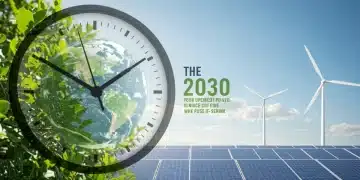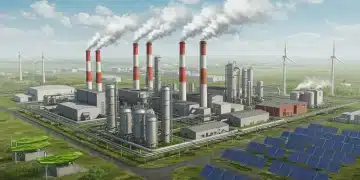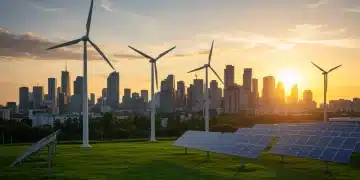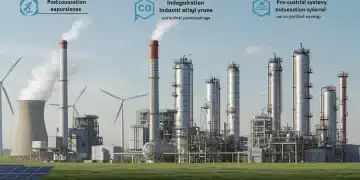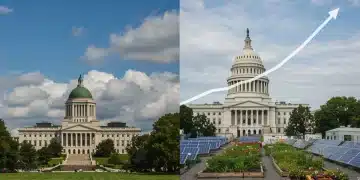Achieving 50% Emission Reduction by 2030: U.S. Policy Roadmap
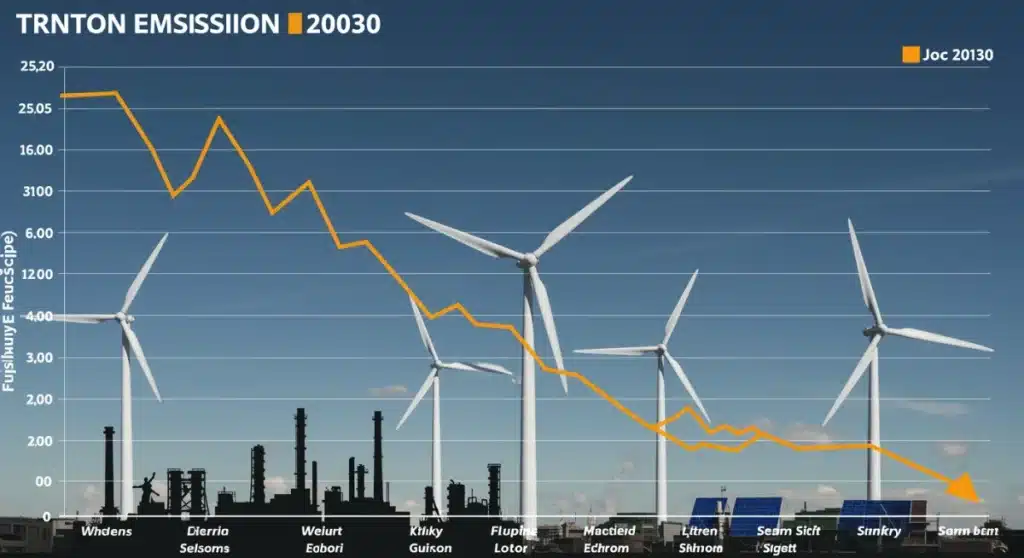
Achieving 50% Emission Reduction by 2030: A Policy Roadmap for U.S. Industries (PRACTICAL SOLUTIONS, TIME-SENSITIVE) outlines urgent strategies and policy shifts essential for the United States to meet its ambitious climate targets.
The imperative to achieve a 50% Emission Reduction by 2030: A Policy Roadmap for U.S. Industries (PRACTICAL SOLUTIONS, TIME-SENSITIVE) is now more critical than ever. New federal and state initiatives, as of late May 2024, are intensifying focus on decarbonization across key U.S. industrial sectors, signaling a pivotal moment for climate action.
The Urgency of the 2030 Target
The United States has committed to reducing its greenhouse gas emissions by 50-52% below 2005 levels by 2030. This ambitious target, reiterated by the Biden administration, demands immediate and transformative action across all sectors, particularly heavy industry. The window for effective intervention is narrowing, making the implementation of robust policy roadmaps paramount.
Recent reports, including those from the Environmental Protection Agency (EPA) and the Department of Energy (DOE), confirm that while progress has been made, the pace of decarbonization needs to accelerate significantly. Industry leaders and policymakers are currently engaged in discussions to streamline regulatory processes and incentivize green technologies, reflecting a growing consensus on the necessity for swift action.
Federal Policy Frameworks Driving Change
Federal policy remains the primary lever for systemic change. The Inflation Reduction Act (IRA) stands as a cornerstone, providing substantial tax credits and incentives for clean energy deployment and industrial decarbonization. Its impact is already visible in increased investments in renewable energy projects and electric vehicle manufacturing.
Key Federal Initiatives
Several key federal initiatives are shaping the landscape for emission reduction. These programs aim to provide both financial backing and regulatory guidance for industries transitioning to lower-carbon operations.
- Clean Energy Tax Credits: Extended and expanded under the IRA, these credits incentivize solar, wind, and other renewable energy sources.
- Industrial Decarbonization Fund: Established to support research, development, and demonstration projects for hard-to-abate industrial emissions.
- Methane Emission Reduction Program: Targets significant reductions in methane leaks from oil and gas operations, a potent greenhouse gas.
Additionally, the Department of Transportation (DOT) is advancing regulations to promote cleaner transportation, including emissions standards for vehicles and investments in electric vehicle charging infrastructure. These interconnected policies create a comprehensive approach to tackling emissions across various segments of the economy.
Sector-Specific Strategies for Decarbonization
Achieving the 2030 target requires tailored strategies for each major industrial sector. Heavy industries such as steel, cement, and chemicals face unique challenges due to their energy-intensive processes and reliance on fossil fuels. However, innovative solutions are emerging, supported by government incentives and private sector investment.
For the steel industry, the focus is on transitioning to electric arc furnaces (EAFs) powered by renewable electricity and exploring green hydrogen as a reductant. In cement production, carbon capture, utilization, and storage (CCUS) technologies are being piloted to trap emissions from kilns. These technologies, while still developing, offer significant potential for deep decarbonization.
Transitioning Key Industries
The transition in key industrial sectors involves a blend of technological innovation, infrastructure development, and policy support. Each sector presents distinct opportunities and obstacles.
- Manufacturing: Shifting to electrified processes, improving energy efficiency, and adopting sustainable materials.
- Chemicals: Developing bio-based feedstocks and deploying advanced catalysis for lower-emission production methods.
- Oil & Gas: Implementing strict methane emission controls and investing in carbon capture technologies for existing facilities.
The EPA recently announced new proposed rules for power plant emissions, which, if finalized, would significantly accelerate the retirement of coal-fired plants and encourage the adoption of cleaner energy sources. This move directly impacts industrial energy consumption, pushing towards a greener grid.
The Role of Innovation and Technology
Technological innovation is indispensable for meeting the 2030 emission reduction goals. Breakthroughs in renewable energy, energy storage, carbon capture, and green hydrogen production are critical enablers. Public-private partnerships are accelerating the development and deployment of these advanced solutions.
For instance, advancements in battery technology are making grid-scale energy storage more viable, supporting the integration of intermittent renewable energy sources like solar and wind. Similarly, direct air capture (DAC) technologies, though nascent, hold promise for removing legacy carbon from the atmosphere, complementing emission reduction efforts.

Emerging Technologies for Decarbonization
A host of emerging technologies are poised to revolutionize industrial processes, offering pathways to significant emission reductions. Investment in these areas is crucial for long-term success.
- Green Hydrogen: Produced via electrolysis powered by renewables, green hydrogen offers a clean fuel and feedstock alternative for heavy industry.
- Advanced Nuclear Power: Small Modular Reactors (SMRs) provide a reliable, carbon-free energy source for industrial heat and electricity.
- Geothermal Energy: Tapping into Earth’s heat for industrial processes and electricity generation, offering continuous clean energy.
The Department of Energy has allocated substantial funding towards these innovative technologies, recognizing their potential to transform the industrial landscape. These investments are designed to de-risk new technologies and accelerate their commercialization, making them accessible to a wider range of industries.
Financing the Transition: Economic Incentives and Investment
The transition to a low-carbon economy requires massive financial investment. Government incentives, private capital, and innovative financing mechanisms are all playing a role in mobilizing the necessary funds. The IRA alone is projected to unlock trillions in private investment over the next decade.
Beyond federal programs, state-level initiatives and green financing products from banks and investors are channeling capital towards decarbonization projects. Carbon markets, both compliance and voluntary, also provide a mechanism for pricing carbon and incentivizing emission reductions, creating a clear economic signal for industries.
Mobilizing Capital for Green Projects
Effective financial strategies are essential to support industries in their shift towards sustainability. This involves a mix of public funding, private investment, and market-based mechanisms.
- Green Bonds: Issuance of bonds specifically to finance environmentally friendly projects.
- Blended Finance: Combining public and private capital to reduce risk for investors in green technologies.
- Carbon Pricing Mechanisms: Implementing carbon taxes or cap-and-trade systems to create economic incentives for emission reductions.
Recent data from the Treasury Department indicates a significant uptake in IRA tax credits by manufacturing firms aiming to electrify operations and adopt cleaner production methods. This demonstrates the effectiveness of direct financial incentives in driving industrial change.
Challenges and the Path Forward
Despite significant progress, formidable challenges remain on the path to achieving a 50% emission reduction by 2030. These include the high upfront costs of new technologies, infrastructure limitations, and the need for a skilled workforce to implement and maintain green solutions.
Overcoming these hurdles requires sustained policy commitment, continued innovation, and collaborative efforts between government, industry, and civil society. Developing robust supply chains for critical minerals and renewable energy components is also a pressing concern. The global push for decarbonization intensifies competition for these resources.
Addressing Key Obstacles
A proactive approach to addressing existing challenges is vital for maintaining momentum towards the 2030 climate goals. This involves strategic planning and adaptive policy-making.
- Workforce Development: Investing in training programs for green jobs, ensuring a skilled labor force for new technologies.
- Supply Chain Resilience: Strengthening domestic manufacturing and securing international partnerships for essential components.
- Regulatory Streamlining: Simplifying permitting processes for renewable energy and decarbonization projects to accelerate deployment.
As of late May 2024, discussions are ongoing in Congress regarding potential amendments to existing climate legislation, aiming to further accelerate projects and address implementation bottlenecks. The urgency of the 2030 deadline is driving these legislative considerations.
| Key Policy Area | Brief Description |
|---|---|
| Federal Incentives | Tax credits and funding from the Inflation Reduction Act drive clean energy and industrial decarbonization. |
| Sector-Specific Targets | Tailored strategies for heavy industries like steel, cement, and chemicals to adopt cleaner processes. |
| Technological Innovation | Investment in green hydrogen, advanced nuclear, and carbon capture is crucial for deep decarbonization. |
| Financing Mechanisms | Green bonds, blended finance, and carbon pricing mobilize capital for sustainable industrial projects. |
Frequently Asked Questions on Emission Reduction
The United States aims to reduce its greenhouse gas emissions by 50-52% below 2005 levels by the year 2030. This target is a central pillar of the nation’s climate strategy and aligns with global efforts to combat climate change.
The IRA provides significant tax credits and incentives for clean energy production, energy efficiency, and industrial decarbonization projects. It mobilizes substantial private investment, accelerating the adoption of green technologies across various U.S. industries.
Heavy industries such as steel, cement, chemicals, and manufacturing are critical. These sectors are energy-intensive and require significant technological shifts, including electrification, carbon capture, and the adoption of green hydrogen, to meet reduction goals.
Green hydrogen production, advanced nuclear power (like SMRs), carbon capture, utilization, and storage (CCUS), and enhanced geothermal systems are crucial. These innovations offer pathways to drastically reduce emissions in hard-to-abate sectors.
Significant challenges include high upfront costs for new technologies, the need for robust infrastructure development, and a shortage of skilled labor. Overcoming these requires sustained policy support, innovation, and strong public-private collaboration.
Looking Ahead
The ongoing push for Achieving 50% Emission Reduction by 2030: A Policy Roadmap for U.S. Industries (PRACTICAL SOLUTIONS, TIME-SENSITIVE) will continue to dominate environmental and economic news. Future developments will likely include further regulatory clarifications from the EPA and DOE, new investment announcements from major industrial players, and the unveiling of innovative pilot projects. The success of these initiatives will not only dictate the nation’s ability to meet its climate commitments but also shape its global competitiveness in green technologies. Watch for continued legislative efforts to streamline project approvals and expand workforce development programs.
